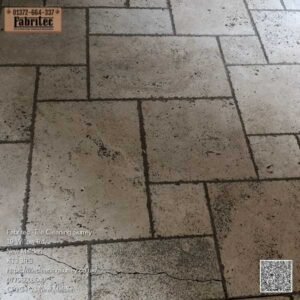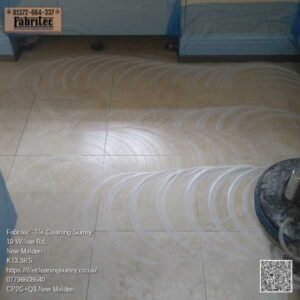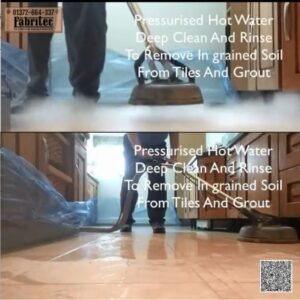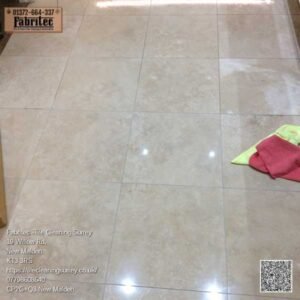Travertine floors radiate timeless elegance and refinement, making them an exceptional choice for discerning homeowners who appreciate quality in their living spaces. However, employing inappropriate cleaning methods can lead to irreversible harm to these beautiful surfaces. If you reside in Kingston-upon-Thames and are considering using a steam cleaner on your stone floors, halt immediately. What may appear to be a harmless cleaning solution could inflict hidden damages that may prove costly to repair. In this comprehensive guide, we will explore the detrimental effects of steam cleaning travertine, share tailored tips for effective maintenance, and suggest safer alternatives to keep your floors looking immaculate.
Explore the Unique Characteristics and Benefits of Travertine Flooring
Travertine is a distinctive type of limestone that forms through mineral deposits in natural hot springs. Its porous characteristics and softer texture, especially when compared to granite, contribute to its natural, earthy aesthetic, enhancing the beauty of any interior environment. However, this porosity also makes it susceptible to absorbing moisture, cleaning agents, and dirt, which underscores the importance of careful maintenance. By familiarising yourself with the attributes of your travertine flooring, you can ensure it retains its beauty and functionality for many years ahead.
Travertine is available in various finishes that significantly influence its appearance and maintenance requirements:
- Honed: This finish yields a smooth, matte surface that is highly desirable for flooring, offering a contemporary feel.
- Polished: This glossy, reflective finish is ideal for those looking to infuse their space with a sense of luxury and glamour.
- Tumbled or Brushed: This option provides a rustic, textured look that cultivates a more natural ambiance within your home.
It is crucial to identify the specific type of travertine you possess before embarking on any cleaning regimen, as each finish responds differently to moisture, heat, and physical pressure. This knowledge will empower you to select the most suitable cleaning methods to preserve your travertine's aesthetic appeal and longevity.
Recognising the Dangers of Steam Cleaning Your Travertine Floors
In summary: Using a steam cleaner on travertine floors is strongly discouraged.
Understand How Heat and Moisture Can Compromise the Integrity of Travertine
Steam cleaners release high-temperature vapour onto surfaces. Due to the porous nature of travertine, this can result in:
- Steam permeating the stone, potentially causing internal damage
- Long-term weakening or loosening of the stone’s structural integrity, thus jeopardising its durability
- Surface etching or a haze that detracts from the stone's inherent beauty
Examine How Steam Affects Protective Sealants on Travertine
It is vital to safeguard travertine flooring with an effective sealant. However, steam can:
- Penetrate and deteriorate the sealant prematurely, leaving the stone exposed to damage
- Cause microfractures within the stone, which can exacerbate over time
- Lead to unsightly water stains and hazing on the finish, diminishing the overall aesthetics of your flooring
 How Steam Can Trap Dirt Within the Pores of Travertine
How Steam Can Trap Dirt Within the Pores of Travertine
While steam may seem effective at loosening dirt, without proper extraction, it can inadvertently force grime deeper into the stone, leading to:
- Gradual discolouration that becomes increasingly noticeable over time
- The development of embedded soils within the stone, which can be challenging to remove

Best Practices for Cleaning and Maintaining Travertine Floors in Kingston-upon-Thames
 Opt for pH-Neutral Cleaners for Safe and Effective Maintenance
Opt for pH-Neutral Cleaners for Safe and Effective Maintenance
Harsh alkaline or acidic cleaning agents, such as vinegar or bleach, can significantly deteriorate the quality of the stone. Instead, consider:
- Utilising pH-neutral cleaners specifically formulated for natural stone surfaces
- Exploring local brands or UK-imported solutions that ensure safety for your stone flooring
 Employ a Damp Microfibre Mop for Gentle and Effective Cleaning
Employ a Damp Microfibre Mop for Gentle and Effective Cleaning
Avoid the use of overly saturated mops that can potentially damage your travertine. A damp (not wet) microfibre mop effectively cleans the surface without overwhelming it with moisture, ensuring the longevity and beauty of your flooring.
 Ensure Timely Drying After Mopping to Preserve Your Floors
Ensure Timely Drying After Mopping to Preserve Your Floors
It is imperative to dry travertine floors promptly after mopping to prevent moisture seepage. To achieve this, you can utilise:
- Clean, dry cloths to absorb excess water
- Floor fans, especially in areas with limited ventilation, to promote faster drying
 Re-Seal Your Floors Every 1–2 Years for Long-Lasting Protection
Re-Seal Your Floors Every 1–2 Years for Long-Lasting Protection
Considering the humid climate in the UK, particularly in older homes in Kingston with restricted airflow, the frequency of sealing is essential for preserving the structural integrity and appearance of your travertine flooring.
Safer Alternatives to Steam Cleaning for Travertine Floors
| Cleaning Method | Is it Safe for Travertine? | Additional Notes |
|---|---|---|
| Dry Dust Mopping |  |
Ideal for daily maintenance to keep surfaces clean and dust-free |
| Damp Mop with pH-Neutral Cleaner |  |
Recommended for weekly cleaning to sustain shine and appearance |
| Steam Mop |  |
Risks damaging the stone’s pores and sealant, leading to potentially expensive repairs |
| Acidic Solutions (such as Vinegar) |  |
Can corrode the stone's surface, causing permanent damage |
| Stone-Specific Cleaners |  |
Options include LTP Floorshine, LTP Waxwash, Fila Multi Surface Cleaner, and HG natural stone cleaner for a streak-free finish.
Always perform a spot test first to ensure compatibility with your specific travertine type. |
| Professional Stone Cleaning Services |  |
Ideal for deep cleaning and restoration, offering expert care for your flooring |
Identifying Signs of Steam Damage on Your Travertine Flooring
- Dull patches or etched areas that detract from its overall visual appeal
- White haze or chalky residue indicating moisture-related issues
- Cracking or flaking that compromises the structural integrity of the stone
- Efflorescence, which appears as a white powder due to moisture migration within the stone
Discover Local Travertine Care Services in Kingston-upon-Thames
Travertine Care in Kingston-upon-Thames is a dedicated service that merges contemporary cleaning techniques with the charm of historical architecture. Many properties in this region boast traditional stone floors, and local homeowners, as well as property managers, can trust the professional travertine cleaning services offered by Fabritec Tile Cleaning, based in New Malden.
Is Your Travertine Floor Dull and Grimy?

This customer in Kingston-upon-Thames possessed a stunning travertine floor, yet the tiles lost their original splendour after frequent cleaning with a domestic steam cleaner. The tiles became dull, soiled rapidly after cleaning, and absorbed stains like a sponge, severely diminishing their visual appeal.
Initially, the homeowner contemplated replacing the entire floor. Fortunately, they reached out to the local experts, Fabritec, and that marked the beginning of their restoration journey.
Revitalising a Travertine Tiled Floor Through Professional Deep Cleaning
The initial phase involved restoring the stone's aesthetic and structural integrity through an extensive deep cleaning process. Travertine requires more than a simple wipe-down; effective cleaning necessitates mechanical abrasion and meticulous attention to detail.

- I commenced with a 200-grit pad affixed to a rotary floor machine. By employing slow, circular movements, the pad effectively opened the stone's surface, allowing for the removal of deeply embedded dirt and worn finishes. This process generated a considerable amount of slurry—a mixture of water and dislodged stone particles—that required thorough rinsing and vacuuming.
- After the initial pass, I progressed through a series of finer grits: 400-grit, 800-grit, and ultimately, 1500-grit. Each stage required multiple passes to gradually refine the stone’s finish and enhance its natural sheen. With each level of grit, additional slurry was produced and meticulously extracted to ensure a clean, residue-free surface.
- Importantly, this restoration procedure is entirely mechanical—no chemical strippers were employed, only water. The combination of abrasive pads and dedicated manual effort successfully unveiled the stone’s inherent beauty.
Once the surface was returned to its original splendour, attention focused on the grout lines, which were heavily soiled and did not respond well to pad cleaning. As rotary pads cannot efficiently reach into recessed grout lines, I employed specialised equipment designed specifically for thorough cleaning.
Thorough Grout Cleaning: An Essential Step in the Restoration Process

I applied a potent stone-safe cleaner and degreaser, meticulously incorporating it into the surface using a scrubbing machine. This technique effectively breaks down accumulated grime and emulsifies greasy residues lodged within the pores and grout lines. I allowed it to sit for approximately 10 minutes to penetrate and loosen the embedded soil.
Subsequently, I employed our high-pressure hot water rinse and capture system, which blasts hot water deep into the tiles. This method efficiently flushes out grime from both the grout lines and the natural pits in the travertine that scrubbing alone cannot reach.
Thanks to the heat and effective vacuum extraction, the floor dries remarkably quickly. This rapid drying not only prevents moisture from being reabsorbed into the stone but also prepares the surface for sealing sooner—often within an hour.
Sealing Your Travertine Tiled Kitchen Floor for Long-Term Durability

The homeowner expressed a desire to maintain a natural aesthetic, prompting me to apply a high-quality impregnating sealer specifically designed for polished stone surfaces, ensuring enduring protection and visual appeal.
Frequently Asked Questions Regarding Steam Cleaning Travertine in Kingston-upon-Thames
What is the Most Effective Method to Sanitize Travertine Without Using Steam?
Utilise a diluted pH-neutral cleaner in conjunction with a microfibre cloth for effective sanitation. For a more comprehensive cleaning, consider hiring a professional service that specializes in stone care.
Is Professional Assistance Necessary for Re-Sealing My Travertine?
Not necessarily. While DIY kits are available, a professional ensures comprehensive coverage and selects the most suitable product for your specific type of flooring, enhancing its durability and longevity.
What Consequences Occur If Water Stands on Travertine?
Stagnant water can penetrate the stone, resulting in dark patches, compromising the structural integrity, and potentially fostering mould growth, which can be detrimental to your home's environment.
Can Travertine Floors Be Buffed After Experiencing Steam Damage?
Yes, minor etching or haziness may be rectified through honing and polishing. It is advisable to consult a stone care expert to achieve optimal results and restore the floor’s original beauty.
Essential Resources for Proper Travertine Care
The article Should You Steam Clean Travertine Floors? A Comprehensive Guide for Homeowners in Kingston-upon-Thames originally appeared on Tile Cleaning Surrey.
The Article Steam Clean Travertine Floors: Essential Guide for Homeowners appeared first on https://fabritec.org
The Article Steam Clean Travertine Floors: A Homeowner’s Essential Guide Was Found On https://limitsofstrategy.com

